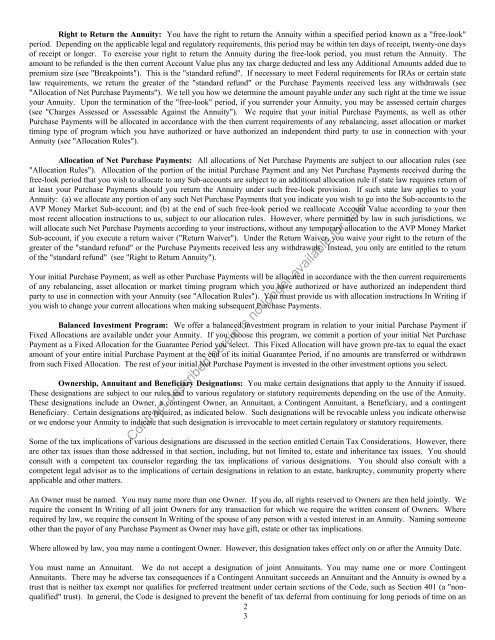Navigator - Prudential Annuities
Navigator - Prudential Annuities
Navigator - Prudential Annuities
Create successful ePaper yourself
Turn your PDF publications into a flip-book with our unique Google optimized e-Paper software.
Right to Return the Annuity: You have the right to return the Annuity within a specified period known as a "free-look"period. Depending on the applicable legal and regulatory requirements, this period may be within ten days of receipt, twenty-one daysof receipt or longer. To exercise your right to return the Annuity during the free-look period, you must return the Annuity. Theamount to be refunded is the then current Account Value plus any tax charge deducted and less any Additional Amounts added due topremium size (see "Breakpoints"). This is the "standard refund". If necessary to meet Federal requirements for IRAs or certain statelaw requirements, we return the greater of the "standard refund" or the Purchase Payments received less any withdrawals (see"Allocation of Net Purchase Payments"). We tell you how we determine the amount payable under any such right at the time we issueyour Annuity. Upon the termination of the "free-look" period, if you surrender your Annuity, you may be assessed certain charges(see "Charges Assessed or Assessable Against the Annuity"). We require that your initial Purchase Payments, as well as otherPurchase Payments will be allocated in accordance with the then current requirements of any rebalancing, asset allocation or markettiming type of program which you have authorized or have authorized an independent third party to use in connection with yourAnnuity (see "Allocation Rules").Allocation of Net Purchase Payments: All allocations of Net Purchase Payments are subject to our allocation rules (see"Allocation Rules"). Allocation of the portion of the initial Purchase Payment and any Net Purchase Payments received during thefree-look period that you wish to allocate to any Sub-accounts are subject to an additional allocation rule if state law requires return ofat least your Purchase Payments should you return the Annuity under such free-look provision. If such state law applies to yourAnnuity: (a) we allocate any portion of any such Net Purchase Payments that you indicate you wish to go into the Sub-accounts to theAVP Money Market Sub-account; and (b) at the end of such free-look period we reallocate Account Value according to your thenmost recent allocation instructions to us, subject to our allocation rules. However, where permitted by law in such jurisdictions, wewill allocate such Net Purchase Payments according to your instructions, without any temporary allocation to the AVP Money MarketSub-account, if you execute a return waiver ("Return Waiver"). Under the Return Waiver, you waive your right to the return of thegreater of the "standard refund" or the Purchase Payments received less any withdrawals. Instead, you only are entitled to the returnof the "standard refund" (see "Right to Return Annuity").Your initial Purchase Payment, as well as other Purchase Payments will be allocated in accordance with the then current requirementsof any rebalancing, asset allocation or market timing program which you have authorized or have authorized an independent thirdparty to use in connection with your Annuity (see "Allocation Rules"). You must provide us with allocation instructions In Writing ifyou wish to change your current allocations when making subsequent Purchase Payments.Balanced Investment Program: We offer a balanced investment program in relation to your initial Purchase Payment ifFixed Allocations are available under your Annuity. If you choose this program, we commit a portion of your initial Net PurchasePayment as a Fixed Allocation for the Guarantee Period you select. This Fixed Allocation will have grown pre-tax to equal the exactamount of your entire initial Purchase Payment at the end of its initial Guarantee Period, if no amounts are transferred or withdrawnfrom such Fixed Allocation. The rest of your initial Net Purchase Payment is invested in the other investment options you select.Ownership, Annuitant and Beneficiary Designations: You make certain designations that apply to the Annuity if issued.These designations are subject to our rules and to various regulatory or statutory requirements depending on the use of the Annuity.These designations include an Owner, a contingent Owner, an Annuitant, a Contingent Annuitant, a Beneficiary, and a contingentBeneficiary. Certain designations are required, as indicated below. Such designations will be revocable unless you indicate otherwiseor we endorse your Annuity to indicate that such designation is irrevocable to meet certain regulatory or statutory requirements.Contract described herein is no longer available for sale.Some of the tax implications of various designations are discussed in the section entitled Certain Tax Considerations. However, thereare other tax issues than those addressed in that section, including, but not limited to, estate and inheritance tax issues. You shouldconsult with a competent tax counselor regarding the tax implications of various designations. You should also consult with acompetent legal advisor as to the implications of certain designations in relation to an estate, bankruptcy, community property whereapplicable and other matters.An Owner must be named. You may name more than one Owner. If you do, all rights reserved to Owners are then held jointly. Werequire the consent In Writing of all joint Owners for any transaction for which we require the written consent of Owners. Whererequired by law, we require the consent In Writing of the spouse of any person with a vested interest in an Annuity. Naming someoneother than the payor of any Purchase Payment as Owner may have gift, estate or other tax implications.Where allowed by law, you may name a contingent Owner. However, this designation takes effect only on or after the Annuity Date.You must name an Annuitant. We do not accept a designation of joint Annuitants. You may name one or more ContingentAnnuitants. There may be adverse tax consequences if a Contingent Annuitant succeeds an Annuitant and the Annuity is owned by atrust that is neither tax exempt nor qualifies for preferred treatment under certain sections of the Code, such as Section 401 (a "nonqualified"trust). In general, the Code is designed to prevent the benefit of tax deferral from continuing for long periods of time on an23
















